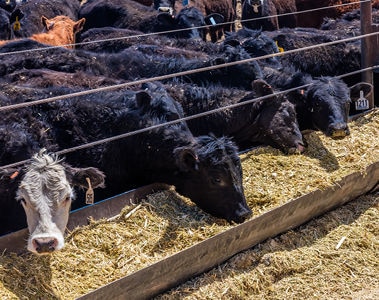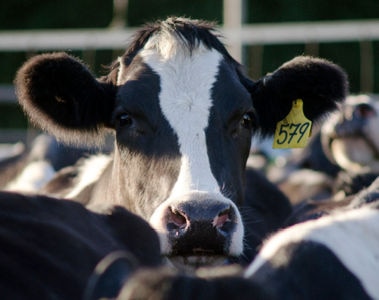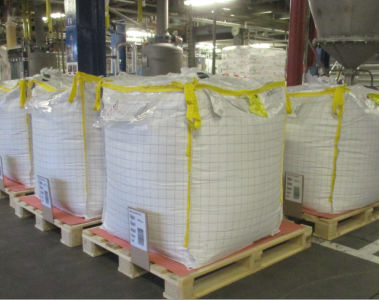Product Form, Ligand and Manufacturing Technologies
Dry Product Forms
For supplementation of vitamins A, D and E through premixes, compound feeds and milk replacers (in the case of solutions dispersible in water), dsm-firmenich manufactures a product range where each vitamin is uniquely formulated into a vitamin blend, stabilized appropriately and using the most advanced manufacturing technology to ensure optimal stability in the feed and bioavailability in the animal. These product solutions are suitable for inclusion through micro-dosing machines too. Vitamin A is manufactured using beadlet technology, provided as Rovimix® A 1000 (formulated as a combination of synthetic esters of retinol vitamin A and propionate and palmitate). Considering the reactivity of vitamin A, it is stabilized with butylated hydroxytoluene prior to dispersion in the beadlet matrix. For use in milk replacers, Rovimix® A 500 WS, a spray dried product, provides a water-soluble option to supplement vitamin A. Vitamin D3 (cholecalciferol) is available as Rovimix® D3-500, stabilized with butylated hydroxytoluene and manufactured using spray drying technology, rendering it dispersible in water. Rovimix® AD3 1000/200 provides a convenient combination vitamin A and D solution manufactured through beadlet technology. Supplementation of 25-hydroxyvitamin D3 in cattle diets, the circulating form of vitamin D, with proven immune health and growth performance benefits in cattle (Martins et al., 2025) is done through Rovimix® Hy-D 1.25 %. The 25-hydroxyvitamin D3 is stabilized with butylated hydroxytoluene and sodium ascorbate prior to spray dried. Vitamin E is manufactured as an adsorbate where the active vitamin is adsorbed onto silicic acid, available as the product Rovimix® E-50 adsorbate (α-tocopherol acetate) to be included in compound feeds and premixes.
Dispersible Liquid Concentrates
dsm-firmenich has been the pioneer in the development of dispersible liquid concentrates (DLC) and set a new benchmark for targeted and precise vitamin delivery in cattle feed applications. These DLC’s are highly concentrated colloidal dispersions of vitamins, mixed with food grade emulsifiers and solvents to provide vitamin formulations with maximum dispersibility and suspension characteristics. Dispersible liquid concentrates are intended for inclusion in liquid feed supplements, specifically formulated to be miscible (forming a homogenous mixture) with thixotropic liquids which are viscous, thick liquids when not stirred or shaken but flow when agitated or stirred (Barnes, 1997), such as molasses-based supplements. Dispersible liquid concentrates are uniquely suited for inclusion through micromachines (ensuring accurate and consistent nutrient delivery) and in free choice liquid supplements or liquid supplements later included into a total mixed ration or complete feed. In the manufacturing of DLC’s, polysorbate is used as a solubilizing and dispersion agent, ensuring uniform distribution of vitamins in the formulation. Propylene glycol lowers the freezing point of the mixture, prevention settling and solidification in cold environments. Propionic acid is also included for its anti-microbial properties.
The unique formulation and manufacturing process used to produce DLC’s ensures a product that is dispersible, stays in suspension (with no separation at temperatures between 110 to 120º F), does not gel at low temperatures remain liquid at 1-3º F), are highly bioavailable, free flowing, water dispersible, emulsifiable, miscible with thick, viscous liquids such as molasses and suited for use in micromachines, free choice liquid feeds and concentrated liquid supplements.
Vitamin A, D and E are available either as a standalone Rovimix® DLC or in combination (also custom blends on request) and 25-hydroxyvitamin D3 is available as a standalone formulation, HyD® Solution. Within the DLC vitamin A is provided as a highly concentrated, bioavailable vitamin A propionate and palmitate combination, vitamin D 3 as a high potency cholecalciferol and vitamin E as dl-α-tocopheryl acetate, stable and highly concentrated.
The effectiveness of dispersible liquid concentrates are equal to or in some cases even exceeds that of dry vitamin formulations in terms of stability in feed applications and bioavailability in the animal. In comparing the effectiveness of DLC’s compared to dry vitamin formulations in lambs, the bioavailability of vitamin A in the DLC formulation proved superior with serum retinol levels (indication of vitamin A status in animal) analyzing at 319 ng/ml compared to 289 ng/ml when fed (Johnson, 2002).



